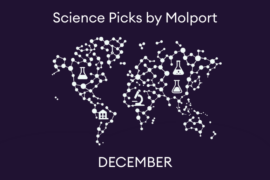May 12th
Real Way to Target Gram-Negative Pathogens: Discovery of a Novel Helicobacter pylori Antibiotic Class
https://pubs.acs.org/doi/abs/10.1021/acs.jmedchem.5c00112
Abstract
In an era of escalating antibiotic resistance, there is a pressing need for innovative strategies to develop novel antibiotics. Gram-negative bacteria, characterized by their robust dual-membrane, are intrinsically resistant to a wide range of antibiotics and can readily develop new resistances. Members of this bacterial class comprise numerous pathogenic organisms, including the primary cause of gastric cancer, Helicobacter pylori. In this study, we used the Giga-sized collection of theoretical molecules inside Enamine’s REAL Space to identify inhibitors for H. pylori glutamate racemase. These compounds displayed a diverse range of activity in preventing H. pylori growth, with our most potent hits capable of selective full growth inhibition for metronidazole and clarithromycin resistant H. pylori strains. Alongside the introduction of a novel antibiotic class for this carcinogenic pathogen, our unique implementation of REAL Space holds great promise for Gram-negative antibiotic development as a whole.
May 9th
Discovery of HM-279, a Potent Inhibitor of ALK5 for Improving Therapeutic Efficacy of Cancer Immunotherapy
https://pubs.acs.org/doi/abs/10.1021/acs.jmedchem.4c02293
Abstract
Activin receptor-like kinase 5 (ALK5) is a type I receptor serine/threonine kinase and responsible for the TGF-β signaling pathway. ALK5 is thought to be a key player in the tumor microenvironment to promote tumor progression by affecting the anticancer immunity. Therefore, ALK5 is an attractive drug target for modulating TGF-β signaling pathways to improve the therapeutic efficacy of cancer immunotherapy. We report the optimization of a series of thiazole analogues starting from lead compound 6, focusing on improving off-target selectivity. Compound 19f (HM-279) was identified as a potent ALK5 inhibitor with an acceptable off-target selectivity and favorable ADME/PK properties. Oral administration of HM-279 demonstrated antitumor activity in a CT26.WT colon carcinoma syngeneic mouse model as a single agent and in combination with the anti-PD-1 antibody through CD8+ T cell immunity.
May 6th
DNA-Encoded Library Screen Identifies Novel Series of Respiratory Syncytial Virus Polymerase Inhibitors
https://pubs.acs.org/doi/epdf/10.1021/acs.jmedchem.4c03016?ref=article_openPDF
Abstract
Respiratory syncytial virus (RSV) remains a public health burden due to unmet therapeutic needs. We recently reported the discovery of a non-nucleoside inhibitor of the RSV polymerase and characterized its binding to a novel pocket within the capping domain of the polymerase. Here, we describe our strategy to diversify the chemical matter targeting this site by screening our DNA-encoded chemical libraries, leading to the discovery of a novel and potent series of molecules that inhibits RSV polymerase’s biochemical activity, as well as its viral replication in cells. Structural analysis via cryo-EM revealed novel contacts made within the capping domain binding pocket. By leveraging these structural insights for preliminary SAR exploration, we generated analogues for which potency and metabolic stability were improved more than 60- and 40-fold, respectively, over the initial hit. This work provides a path forward for further advanced SAR exploration and development of therapeutics against RSV.
May 2nd
DNA-Encoded Library Screen Identifies Novel Series of Respiratory Syncytial Virus Polymerase Inhibitors
https://pubs.acs.org/doi/abs/10.1021/acs.jmedchem.4c02906
Abstract
Respiratory syncytial virus (RSV) remains a public health burden due to unmet therapeutic needs. We recently reported the discovery of a non-nucleoside inhibitor of the RSV polymerase and characterized its binding to a novel pocket within the capping domain of the polymerase. Here, we describe our strategy to diversify the chemical matter targeting this site by screening our DNA-encoded chemical libraries, leading to the discovery of a novel and potent series of molecules that inhibits RSV polymerase’s biochemical activity, as well as its viral replication in cells. Structural analysis via cryo-EM revealed novel contacts made within the capping domain binding pocket. By leveraging these structural insights for preliminary SAR exploration, we generated analogues for which potency and metabolic stability were improved more than 60- and 40-fold, respectively, over the initial hit. This work provides a path forward for further advanced SAR exploration and development of therapeutics against RSV.





